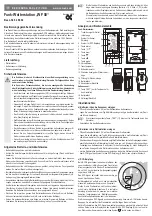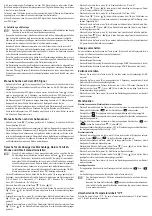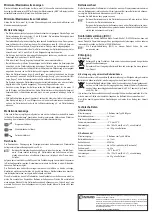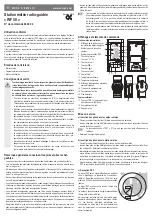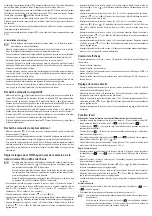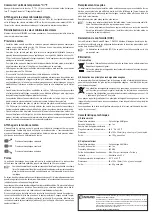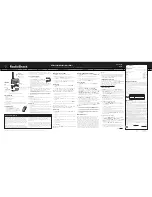
Intended use
The product is used to measure and display the indoor/outdoor temperature. Setting the time
and date is carried out via the integrated DCF receiver; where there are reception problems, a
manual setting is also possible. The weather station also calculates the weather forecast for the
next 12-24 hours by observing the changes in the atmospheric pressure.
The product is battery-operated.
Always observe the safety instructions and all other information included in these operating
instructions.
This product complies with the applicable national and European requirements. All names of
companies and products are the trademarks of the respective owners. All rights reserved.
Package contents
• Weather station
• Outdoor sensor with bracket
• Operating instructions
Safety Instructions
The warranty will be void in the event of damage caused by failure to observe
these safety instructions. We do not assume any liability for any resulting
damage.
We shall not accept liability for damage to property or personal injury caused
by incorrect handling or non-compliance with the safety instructions. In such
cases, the warranty will be null and void.
• The unauthorised conversion and/or modi
fi
cation of the product is not permitted for
safety and approval reasons (CE). Never dismantle the product, except for insert-
ing or replacing the batteries as described in this operating manual.
• Do not use this product in hospitals or medical institutions. Although the outdoor
sensor emits only relatively weak radio signals, these may lead to the malfunction
of life-support systems. The same may also apply to other areas.
• The product is not a toy and does not belong in the hands of children. It contains
small parts, glass (display) and batteries.
• The weather station is only suitable for dry, enclosed indoor areas. Do not expose
it to direct sunlight, strong heat, cold, dampness or wetness; otherwise it may be
damaged.
• The outdoor sensor is suitable for use in protected outdoor areas. It must not be
used in or under water, this will destroy it.
• Do not leave packaging material carelessly lying around, since it could become a
dangerous plaything for children.
• Handle the product with care; it can be damaged by impacts, blows, or accidental
falls, even from a low height.
General instructions for batteries and rechargeable batteries
• Batteries/rechargeable batteries must be kept out of the reach of children.
• Check that the polarity is correct when inserting the batteries/rechargeable batteries (pay
attention to plus and minus).
• Do not leave batteries/rechargeable batteries lying around; they could be swallowed by chil-
dren or pets. If swallowed, consult a doctor immediately, it could be fatal!
• Make sure that batteries/rechargeable batteries are not short-circuited, dismantled or thrown
into a
fi
re. There is a risk of
fi
re and explosion!
• Old or
fl
at batteries can leak liquid chemicals that may damage the device. If not used for a
longer period (e.g., in case of storage), remove the inserted batteries/rechargeable batteries.
• Contact of leaking or damaged batteries/rechargeable batteries with the skin can cause acid
burns; therefore, use suitable protective gloves.
Liquids leaking from batteries are very chemically aggressive. Objects or surfaces com-
ing into contact with these liquids might be considerably damaged. Thus, store batteries/
rechargeable batteries in a suitable location.
• Always replace the complete set of batteries/rechargeable batteries. Do not mix batteries/
rechargeable batteries with different charges (
fl
at and half-discharged batteries/rechargeable
batteries).
• Use either batteries or rechargeable batteries; never mix standard batteries with recharge-
able batteries. Use only batteries/rechargeable batteries of the same model and type and
from the same manufacturer.
It is possible to operate the weather station and the outdoor sensor with recharge-
able batteries. However, the operating time and the display contrast are reduced by
the lower voltage (battery = 1.5V, rechargeable battery = 1.2V). Since rechargeable
batteries are very sensitive to cold, the service life of the outdoor sensor is reduced
further during the winter.
Therefore, we recommend operating both the weather station and the outdoor sen-
sor with high-quality alkaline batteries to ensure long and reliable operation.
Indicators and controls
Radio Weather Station:
1 Weather trend display
2 Icon for sensor reception
3 Icon for DCF reception
4 "Alarm"
button
5
"°C/°F"
button
6 "Mem"
button
7 " " button
8 " " button
9 "Mode"
button
10 Time/ date
11 Indoor temperature
12 Outdoor temperature
13 Graphic display of the weather
forecast
14 Openings for wall mounting
15 Battery compartment
16 Detachable base
Outdoor sensor:
17 "TEST" button (only for purpose of
testing by the manufacturer)
18 Battery compartment
19 Bracket/ base
Getting started
a) Inserting batteries into the outdoor sensor
• Open the battery compartment (18) on the rear of the outdoor sensor.
• Insert two AAA/Micro batteries into the battery compartment paying attention to the correct
polarity (observe po and negative/-).
The recessed "TEST" (17) button is used only for the purpose of testing by the
manufacturer.
• Close the battery compartment again.
b) Inserting batteries into the weather station
• Open the battery compartment (15), at the back of the weather station.
• Insert two batteries of type AA/Mignon with correct polarity into the weather station (observe
po and negative/-). Close the battery compartment again.
• As soon as the batteries are inserted, the weather station brie
fl
y shows all display segments
and then starts the search for the radio signal of the outdoor sensor for about 2 minutes.
The icon for the radio reception (2)
fl
ashes. Do not press any buttons and do not move the
weather station and the outdoor sensor.
• Once the weather station
fi
nds the outdoor sensor, it starts the search for the DCF signal and
the icon for DCF reception (3)
fl
ashes; see next section.
c) DCF reception
The DCF signal is a signal broadcast from a transmit-
ter in Main
fl
ingen (near Frankfurt am Main). Its range
is up to 1500 km and, under ideal reception condi-
tions, even up to 2000 km.
The DCF signal also contains the exact time and the
date, among other things.
Naturally, this also eliminates the hassle of manually
setting summer and winter times.
Do not place the weather station next to electronic
devices, metal parts, cables and so on. Bad reception
can also be expected with metallised insulating glass
windows, reinforced concrete constructions, coated
special wallpaper or in cellar rooms.
The recognition and interpretation of the DCF signal can take about 5-10 minutes. Do not move
the weather station during that time. Do not use any buttons.
When the weather station has read the DCF signal correctly, the current time of the day and
the date will be displayed at the bottom of the display and the DCF reception symbol (3) stops
fl
ashing. During summer time the " " icon appears to the right of the time.
O P E R A T I N G I N S T R U C T I O N S www.conrad.com
Radio-controlled Weather Station
“WF 50“
Item no. 64 68 04
Version 08/13

